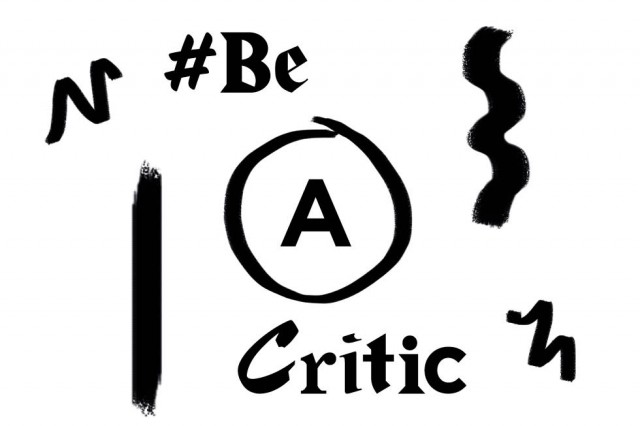To Be A Critic?

As we say goodbye to Brian Sewell, Laura Harris asks what it means to be a critic: from the pages of first century literary criticism, to the pages of 21st century newspapers…
Brian Sewell died last week. A controversial art critic, Sewell (born 1931) was infamous for his vicious pen. From Princess Diana to Nicholas Serota, Sewell’s abrasive criticism made no concessions in its victims; even if this led him to err on the wrong side of sexist. Perhaps the most evocative of his feuds was with R.B. Kitaj, who blamed Sewell’s scathing criticism of his work for the death of his wife. The critic appears here as a malevolent character; but should Sewell, in the name of arts criticism, have sugared his pills?
Even within the ivory towers of the art-world, opinion is divided about the role of the critic. Earlier this year, Tim Marlow — Royal Academy artistic director and arts writer — advised the 15 winners of the #BeACritic campaign (an annual programme of mentoring and commissioned critical articles for North-West-based writers) to “be nice” in their criticism. This, he explained, was the best way to “nurture a small arts scene like Liverpool’s”. Contrary to the wilful divisiveness of Sewell, Marlow was suggesting that critics should be little more than the ad-men of the art-world whose raison d’etre is to encourage and promote.
Both of these men can’t be right. Should the critic be constantly nipping at the ankles of the art-world, keeping it on its toes and forcing it to keep moving? Or should the critic rather be an oarsman of the arts, servant to its tides? A survey of the critical canon shows this debate to be nearly as old as art itself.
Ancient literary commentator Zoilus (400-320 BC) made a name for himself as perhaps the first ‘malevolent’ critic. His Homeric Questions (now lost) nit-picked Homer’s epic poems, criticising their discontinuities and alleged blasphemy. Criticising one of ancient history’s most loved and revered artists won Zoilus few friends, and his notoriety reverberated through the ages, earning him a place in Cervantes’ preface to Don Quixote (1605) as a ‘scoundrel’: ‘Every poet has his Zoilus’.
English satirical poet Alexander Pope (1688-1744) certainly considered his contemporaries to be blighted by such Zoiluses. In 1711, he turned his pen on these detractors, composing An Essay on Criticism:
‘…The gen’rous Critick fann’d the Poet’s Fire,
And taught the World, with Reason to Admire.
Then Criticism the Muse’s Handmaid prov’d,
To dress her Charms, and make her more belov’d…’

Pope’s poem advocates the critics’ capacity to nurture the arts through flattery, while condemning critics’ tendency towards being ‘spite[ful]… fools… itching to deride’. Such a description is strikingly similar to the characterisation of Sewell by the contemporary arts world.
It was in 17th and 18th century France, however, that visual arts criticism became a more prominent pursuit. At this time, the Salons of Paris were flourishing, early iterations of the ‘degree show’ displaying works by recent graduates and early-career artists. In 1725, these exhibitions became public, marking a shift away from a closeted art-world to one that relied on public favour and patronage. Such an atmosphere paved the way for the burgeoning careers of critics, most notable among them Denis Diderot (1713-1784).
Diderot’s reflections of the French Salons are seminal texts in the critical canon, particularly his work on The Salon of 1765. In the preface, Diderot sets out the scope of his criticism of which contemporary critics ought still to take heed:
‘Here is my criticism and my praise. I extol or censure in accordance with my own feelings, which should not be taken as law… the phrases ‘that’s beautiful’ and ‘that’s bad’ are quickly uttered; but the justification of one’s pleasure or displeasure requires time’.
Keen to highlight the subjectivity of his writings, Diderot sidesteps the troublesome critical tendency to make objective value judgements, or to rely on what Pope had called ‘true taste’. Instead, Diderot carves out a place for the individual voice of a contemplative critic who offers justification to back up their appraisals. He places the critic in opposition to the ‘superficial and distracted eye’; this discouragement of snap judgements reverberates in an age of tweeted and blogged criticism.

With such foundations set in place, criticism flourished. John Ruskin (1819-1900) is a particularly lively character in the critical canon, and, although he championed many artists from JMW Turner to William Morris, he, like Sewell, was not always ‘gen’rous’ in his criticism.
Ruskin versus Whistler, November 1878. Incensed by Ruskin’s description of his Nocturne in Black and Gold: The Falling Rocket (1875) as a ‘pot of paint [flung] in the public’s face”, Whistler took Ruskin to court. While Whistler won, it was hardly one in the face for negative criticism. His reward was pitiful and costs refused: the artist was bankrupt.
In contemporary criticism, it is not just Sewell whose opinions have landed them in controversy, if not in court. The outrage surrounding Guardian art critic Jonathan Jones’s condemnation of the centenary poppy display at the Tower of London last year as ‘a nationalistic tragedy’ hints at the public predilection that the critic ‘be nice’. Suddenly Jones found himself on the other side of criticism: damned as a ‘sneering’ member of the ‘Leftie lot’ by Robert Hardman at The Daily Mail. Even David Cameron waded in, calling the poppies ‘extremely poignant’.
From the pages of first century literary criticism, to the pages of 21st century newspapers, the role of the art critic has defied definition. Certainly, Sewell’s personal opinions are often offensive and misjudged. However, even when he managed to keep his objectionable personal politics distinct from his criticism, his negative reviews were rarely well received. This leaves little space for a critic to be popular if they fail to heed Marlow and ‘be nice’.
Throughout the colourful history of art criticism, both critics and artists alike have managed to agree on one thing: that all criticism must be well-founded. In this, Sewell often failed and, resultantly, his criticism could appear spiteful. However, well-founded criticism should never be shunned in the name of nicety. To do so is to ignore the important role of criticism to hold the arts to account. Be a critic, and be honest.
Laura Harris
This article has been commissioned for the collaborative #BeACritic project — an annual programme of mentoring and commissioned critical articles for North-West-based writers, initiated and supported by The Double Negative, Liverpool John Moores University and Arts Council England. See more here
Read Darren Murphy on The Difference Between the Blogger and the Art Critic






